

The earth rotates ... changing the sky. (animation)
The day/night cycle - As you know, the sun rises in the east and sets in the west. This apparent motion of the sun across the sky is one example of diurnal motion (meaning daily motion). The early Greeks adopted a model where the earth remained stationary and the sun did the moving. But children now learn in kindergarten that the earth rotates on its axis ... making the sun appear to move across the sky. For the same reason, the moon rises and sets each day. In fact, the careful observer will notice that stars rise and set for the same reason. All because the earth is spinning once every 24 hours (actually 23h 56m 04.0905s) on its axis.
Astronomers make maps of the sky and plot the position of stars on these maps. Just as geologists use globes to represent the earth, astronomers use a globe to represent the sky ... the big difference is ... the earth is at the center of this globe. This "sky globe" is known as the celestial sphere. It is as if we are inside a fishbowl looking out.

From any one location on the earth, you can only see ½ of the entire celestial sphere (because the rest is blocked by the earth itself).
Just as a globe of the earth has some standard reference points, so does the celestial sphere.
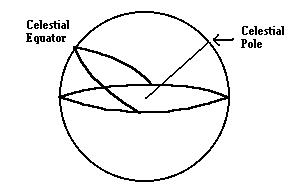
This is how we see the celestial pole and equator from Milwaukee
Because the earth is rotating on its axis, the sky is always changing. During the course of one day, the entire celestial sphere appears to make one complete "orbit" around any stationary observer. This is illustrated in the animation below.
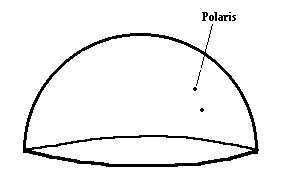 (animation)
(animation)
This leads to some interesting effects ... namely:
If an object is close to Polaris, its diurnal "orbit" may not intersect the horizon and it never rises or sets! These regions are called circumpolar regions. Some very familiar constellations are circumpolar for observers in Milwaukee ... The "Big Dipper" is circumpolar and can be seen any given night in Milwaukee.
Circumpolar region in Milwaukee
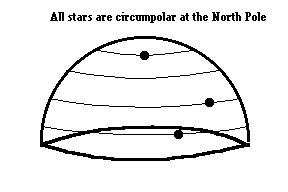 (animation)
(animation)
If interested, you can view a 93 kb movie in AVI format
which shows stars moving parallel to the horizon at the North Pole by clicking
here.
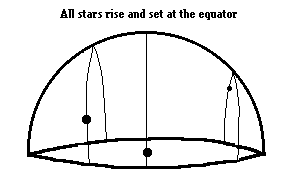 (animation)
(animation)
If interested, you can view a 99 kb movie in AVI format which shows stars rising at the equator by clicking here.
Seasonal cycles - You have lived on the earth long enough to notice some longer term cycles which require one year to complete. The first one you notice are the 4 seasons - winter, spring, summer, and fall. There are specific changes in the climate that Wisconsinites are all too familiar with. But a keen observer will also notice specific seasonal changes occurring in the sky as well. The most obvious is the length of the day in summer vs. winter. In Milwaukee, the longest day is around June 20 or 21 when we get just over 15 hours of sunlight (but only just under 9 hours of sunlight on December 21 or 22). A more careful observer will also notice that the sun's daily path through the sky is radically different at these same times.

For example, on June 20 or 21 in Milwaukee, the sun rises about 33 degrees north of due east ... makes a great arc across the sky (coming just 20 degrees short of zenith at noon ... and setting 33 degrees north of due west. But on Dec 21 or 22, the arc of the sun is just barely above the horizon all day (only getting about 24 degrees above the southern horizon at noon). Finally, the most keen observer will observe that certain constellations are visible at certain times of the year. For example, the constellation Orion is only seen during the winter months and Sagittarius is only seen during the summer.
This is all a result of the earth's revolution around the sun (with a tilt of 23½ degrees).

On March 20 or 21 and September 23 or 24 (the first days of spring and autumn) the sun shines directly over the equator. On June 20 or 21 (the first day of summer in the NH) the sun shines 23½ degrees above the equator on the Tropic of Cancer. Finally, the suns rays shine 23½ degrees below the equator on December 21 or 22 which is the Tropic of Capricorn.
You already know that the sun does not remain fixed in the sky because the earth rotates on its axis. But even the ancient Greeks were aware that the sun does not remain fixed in any one constellation ... but moves along 12 constellations known as the zodiac. It takes a full year for the sun to traverse this path. Technically, this path is called the ecliptic. This is actually a circle around the sky which indicates the path of the sun throughout the year. Detailed sky maps have date marking along the ecliptic which will pin-point the exact location of the sun for any day of the year. It shows that the sun moves eastward along the ecliptic (as measured against the stars)... taking a full year to make one trip around the celestial sphere. Along the way, the sun crosses some points of interest. On March 20 or 21 the sun crosses the Vernal Equinox. There isn't anything interesting there except that this is where the ecliptic intersects the celestial equator (the other point is the Autumnal Equinox on September 23 or 24). The sun also crosses the summer solstice on June 20 or 21 and the winter solstice on December 21 or 22.
If interested, you can view a 115 kb movie in AVI format which shows the sun moving along the ecliptic by clicking here.

Since it takes a full year for the earth the orbit the sun, it should be no surprise that it takes the same time for the sun to trace out the ecliptic. It should also be clear why the sun is on the celestial equator two times of the year ... March 20 or 21 and September 23 or 24! These are the two days the sun's rays are shining directly over the equator and the sun is at one of the equinoxes.
When the sun crosses the Vernal (and Autumnal) Equinox , every point on earth receives 12 hours of daylight and 12 hours of darkness. This marks the first day of spring (or fall).
On June 20 or 21, the Northern Hemisphere is enjoying its summer because the tilt is directed toward us. The sun is 23½ degrees above the celestial equator. On this day the sun makes a huge arc across the sky, and the day is very long.
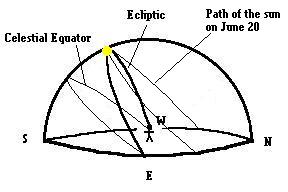
The sun is 23½ degrees above the Celestial Equator on June 20 or 21.
On December 21 or 22, the Northern Hemisphere is tilted away from the sun and we have a very short day. The sun is 23½ degrees below the celestial equator, so the path of the sun on this day will not be very high in the sky.
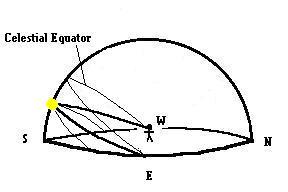
On December 21 or 22, the sun is very low in the sky in Milwaukee
If you happen to live at the north (or south) pole, life gets very interesting! Recall that at the earth's poles, all stars are circumpolar (never rise or set). The celestial pole is at your zenith and the celestial equator defines your horizon. Except for the night Santa takes his sleigh ride, Old St. Nick only gets to see the northern half of the celestial sphere, but it gets even stranger. The sun is above the celestial equator from March 20 or 21 till September 23 or 24. That means the sun is "up" for a whole 6 months. It cracks the horizon on that day (March 20 or 21st) and moves along the horizon all day. Each day it moves a little higher in the sky ... reaching 23½ degrees above the horizon on June 20 or 21 ... then it slowly moves closer to the horizon. It sets on September 23 or 24 and is not seen for another 6 months. Talk about cabin fever!
If all this material is a bit confusing to you ... you are not alone. This is because the earth has two separate motions in space and each one causes different changes in the sky ... and both are occurring at the same time. So let's see if we can filter through this madness and review this logically. The earth rotates on its axis ... causing a 24 hour day/night cycle in the sky. This makes the sun appear to move westward in the sky rather quickly. The earth also revolves around the sun with a 23˝ degree tilt. This causes the seasons and also makes the sun appear to move eastward against the constellations. This motion is much more subtle ... taking a full year for the sun to make one trip along the ecliptic.
ŠJim Mihal 2004 - all rights reserved